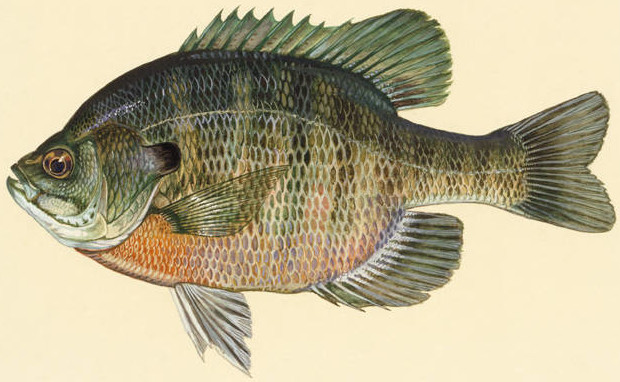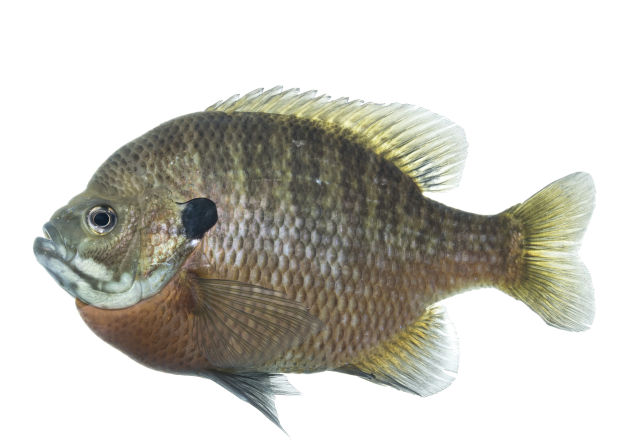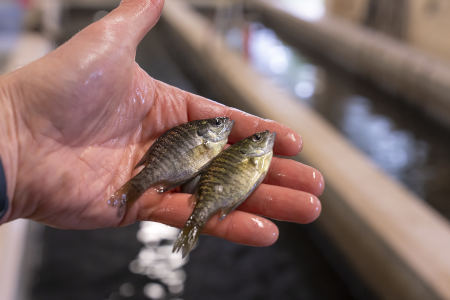Bluegill (Lepomis macrochirus)


The bluegill is a freshwater fish in both the sunfish family Centrarchidae and the true sunfish genus Lepomis. Centrarchidae meaning thorn / sting anus, referring to the presence of spines on the anal fin. Lepomis meaning scaled lid / cover, referring to their signature operculum. Macrochirus meaning large hand, either referring to the long pectoral fins or the overall body shape of the fish. Bluegill are commonly confused with the other sunfishes by anglers unaware of the differences between the species. Bluegill are informally designated as a panfish, arguably the most popular panfish in the USA.
Where to Find Bluegill
The native range consists of the Great Lakes and Mississippi River basins. Due to introductions and stocking efforts now found in rivers and lakes across all of North America. Common species to stock in man-made impoundments like park lakes, farm ponds, or golf courses.
Bluegill can be found throughout the entire water column but for the plurality of the year associated with shallow water. In late spring to summer, they can be found in shallow water spawning grounds as shallow as 1 foot deep. In the winter or other transitionary times be caught as far down as 40 or 50 ft. (although more common deep water fishing is in the 15 to 30 ft range) Bluegill are often found not far from the bank in areas with weed lines or fallen trees. Bluegill will also suspend just below the surface when there is good sunshine to warm themselves up. They can live in creeks and ponds only a few feet deep to massive water reservoirs.

Other Names for Bluegill
Other names people have used to refer to this fish include gill, bream, blue bream, sun perch, brim, blue sunfish, copperbelly, roach, and sunny.
When to Fish for Bluegill
Can be fished for all year long. Most productive times are when water temps are > 50F. Late spring to summer are usually found near shallow water spawning areas. In winter can be taken through the ice or open water.
Diet of Bluegill
Bluegills are omnivores, opportunistic, and bold feeders. As such their exact diet and feeding habits will vary by waterbody and season. Their diet is influenced by their small mouth and skill at sucking in prey.
Cladocera (water fleas) are a major part of their diet, especially for younger bluegill. Chironomidae (lake flies) and terrestrial insects are larger than cladocera and are also major food sources as bluegills grow. Plants can be a significant slice of their diet and to a lesser degree algae as well.
While bluegill will eat minnows, it is typically only a small part of their diet. When available bluegill will eat prey like fishflies, dobsonflies, mayflies, stoneflies, caddisflies, dragonflies, damselflies, water striders, water boatmen, backswimmers, water beetles, common flies, wasps, bees, and ants. If it is a small creature a trout will eat, a bluegill will certainly eat it as well.
- Common Less than half pound
- Trophy 1 - 1.5 lb
- Record 2 lb plus
What Tackle to Use for Bluegill
Bluegill will readily take to most styles of lures or baits. The most common mistake when selecting tackle for bluegill is to use something too big. Hook size 10 to 8 is preferable, 6 if you are just looking for jumbos, 12 and below if you only have small / stunted sized population.
Aberdeen hooks are a popular hook choice for bluegill. However, it should be noted that bluegill can swallow hooks pretty easily and an aberdeen doesn't help reduce that risk. For wire size for bluegill, light wire aberdeen or standard wire aberdeen will both fish well. Going with the light wire will help reduce damage to fish while fighting it and can be expelled from the fish more easily if they swallow the hook. For Eagle Claw 214EL hooks, size 8 is the smaller size to start with and then upsize to size 6 or 4 if needed. If you are fishing for micros or very small bluegill the size 10 will also work.
Recommended lure and jig head is the Trout Magnet or, if only smaller fish are present, the Mini Magnet.
Recommended artificial baits: Crappie Nibbles, Honey Worms, Floating Trout Worm, or Angle Worms
Recommended grocery store baits: corn, bread or marshmallows.
- Common Less than 6 inches
- Trophy 8 to 10 inches
- Record 11 inches plus
Cooking and Eating Bluegill
Bluegill are a good eating fish and a popular fish to catch and cook for recreational anglers. The fan favorite way to cook them is to fry them whole and enjoy them like you would fried chicken. If you fry them whole, the fins and smaller bones can also be eaten and provide a satisfying crunch. Bluegill can also be filleted and you can cook the boneless portions of meat however you wish. However, given that bluegill tend to be on the smaller side and due to their body shape, filleting can waste a lot of meat.
